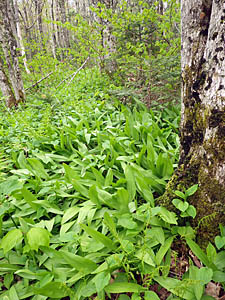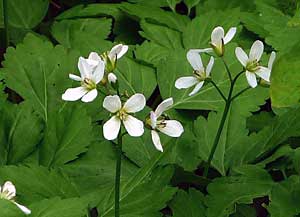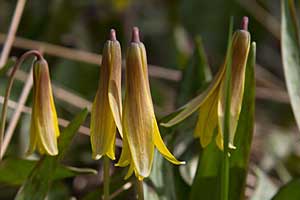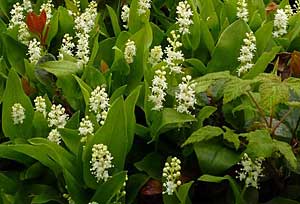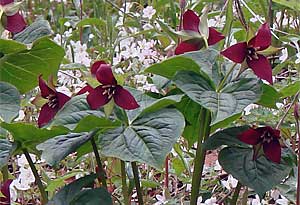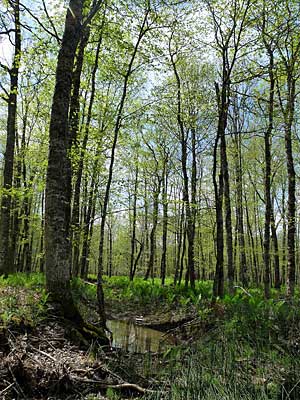|
Panel photo by Patrick Foote
Five of the "true" spring ephemeral species are found in the rich hardwood forests & intervales of Nova Scotia |
|
Photo-essay by JackPine (NSWFS)
Posted 4 Apr. 2012 Update 6 June 2016 The "true" spring ephemeralsThe "spring ephmeral" label is often applied rather loosely to all herbaceous species in eastern hardwood forests that flower before the tree canopy closes. It applies more properly to a "temporal guild" of herbaceous perennials that "emerge and senesce prior to canopy closure",1 i.e., whose above-ground parts, at least, are ephemeral.These species have a small window of sunshine between snowmelt and leaf-out in which to grow, flower, be pollinated, and produce seeds. By mid-June the deciduous trees that tower above have cloaked the forest floor in deep shade. Spring ephemerals disappear in the heat of the summer, retreating underground until next year.2Sometimes this group is referred to as "the true spring ephemerals" to make the distinction from the more loosely applied term. The garden equivalents are the crocusses, daffodils, snowdrops, tulips and the like, which give us the first colour in spring but do not usurp the space for the summer flowers. They are all exotic to North America. By my count, Nova Scotia has five species amongst the dozen or so cited in scientific papers as belonging to the spring ephemeral guild for the hardwood forests of eastern North America3:
Click on photos for larger versions/more photos. More photos of spring ephemerals in Nova Scotia would be welcomed. Comments too!6 |
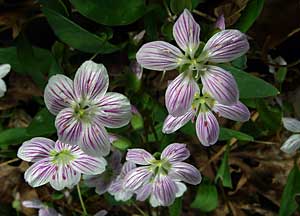 Claytonia caroliniana (spring beauty) at Cape Split, N.S. May 19, 2008  Dicentra cucullaria (Dutchman's breeches) at Cape Split, N.S. May 18, 2008 |
The Early Summer ForbsMany more species belong to the temporal guild of "early summer forbs" or "summer greens" that emerge in spring and persist through canopy closure for varying lengths of time but reach peak coverage before mid summer. 1 As a group, these species grow to taller heights and encompass a wider range of growth forms and habitats than the spring ephemerals.9 Examples of the early summer species in the hardwood and mixed forests of Nova Scotia:
Some might ask whether Hepatica nobilis, one of the NSWFS favourites, fits in this scheme. Hepatica flowers early, but its leaves persist until the next spring bloom. Thus it is clearly not a spring ephemeral and because its leaves persist over winter, it differs from the early spring forbs defined as above. However, it would qualify as a "vernal herb" when that is defined simply as spring flowering herbs. See Hepatica, The Other First Flower of Spring for more about Hepatica. |
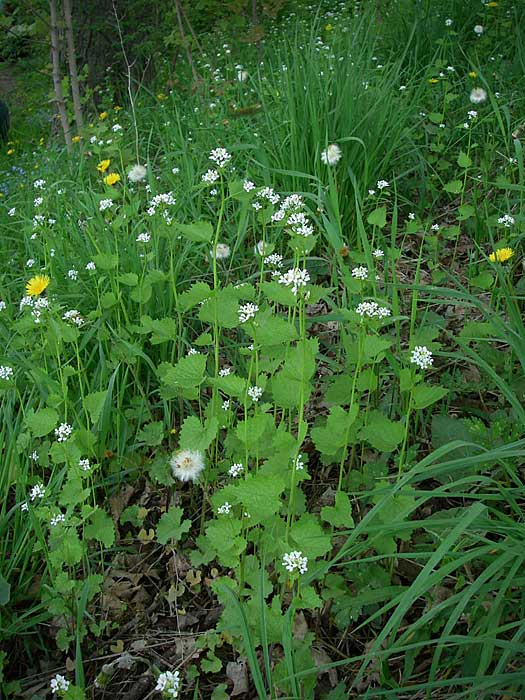 Alliaria petiolata (garlic mustard) in Victoria Park, Truro, N.S. May 23, 2009
| Invasive vernal herb: garlic mustardGarlic mustard (Alliaria petiolata ) is a species of Eurasian origin that invades hardwood forests and outcompetes many of our native vernal herbs. It is a biennial, producing a basal rosette in its first year and flowering shoots in the second year. It is during the second year that it competes significantly with native species. The basal rosettes are capable of high rates of photosynthesis in the early spring while the canopy is open, enabling it to compete with spring ephemerals. Then,…as the canopy closes and native [early spring and summer ] species begin to increase in cover and height, the elongating shoot of A. petiolata supports shade-adapted leaves at higher levels where they could more effectively compete with native species. Thus, A. petiolata grows in the early spring before most native species are actively growing, and extends its growing season into the summer through stem elongation and production of new leaves that are adapted to ambient irradiance levels unlike native ephemeral species or summer forbs. 11White-tailed deer are reported to "assist in its spread by eating native plant species that they prefer and are adapted to eat, leaving the garlic mustard behind." Garlic mustard was apparently introduced to North America in the 1800s for culinary and medicinal purposes.11 It is a relatively recent arrival in N.S., and found in only a few locales, so with some vigilance we could likely limit its spread and damage to native herbs. Glossy and common buckthorns (Rhamnus frangula & Rhamnus cathartica) are also invasive in spring ephemeral habitats in Nova Scotia14 |
Posted 4 Apr. 2012. Modified 6 Jun 2016.
nswildflora.ca


